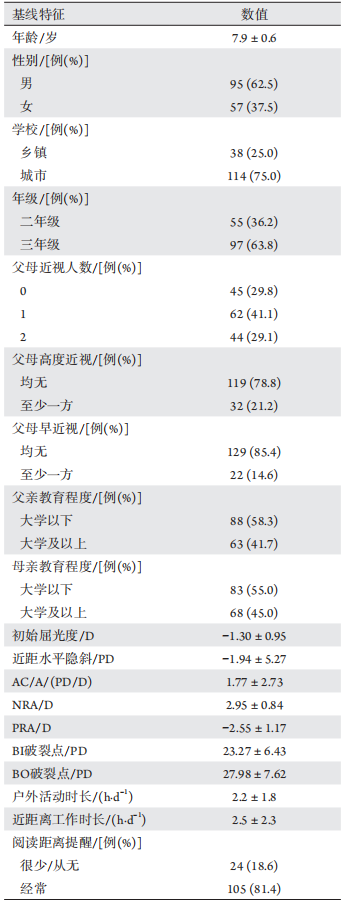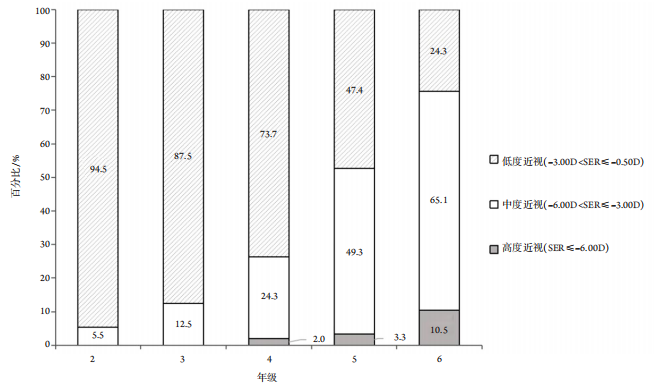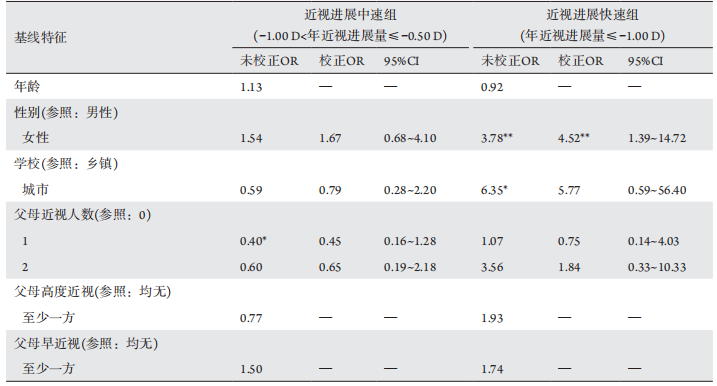1、Rudnicka AR, Kapetanakis VV, Wathern AK, et al. Global variations and time trends in the prevalence of childhood myopia, a systematic review and quantitative meta-analysis: implications for aetiology and early prevention[J]. Br J Ophthalmol, 2016, 100(7): 882-890.Rudnicka AR, Kapetanakis VV, Wathern AK, et al. Global variations and time trends in the prevalence of childhood myopia, a systematic review and quantitative meta-analysis: implications for aetiology and early prevention[J]. Br J Ophthalmol, 2016, 100(7): 882-890.
2、国家卫生健康委员会2021年7月13日新闻发布会介绍儿童青少年近视防控和暑期学生健康有关情况[EB/OL]. [2021-07-13]. http://www.nhc.gov.cn/xwzb/webcontroller.do?titleSeq=11389.国家卫生健康委员会2021年7月13日新闻发布会介绍儿童青少年近视防控和暑期学生健康有关情况[EB/OL]. [2021-07-13]. http://www.nhc.gov.cn/xwzb/webcontroller.do?titleSeq=11389.
3、 [2021-07-13]. http://www.nhc.gov.cn/xwzb/webcontroller.do?titleSeq=11389. [2021-07-13]. http://www.nhc.gov.cn/xwzb/webcontroller.do?titleSeq=11389.
4、Ikuno Y. Overview of the complications of high myopia[J]. Retina, 2017, 37(12): 2347-2351.Ikuno Y. Overview of the complications of high myopia[J]. Retina, 2017, 37(12): 2347-2351.
5、Saw SM, Gazzard G, Shih-Yen EC, et al. Myopia and associated pathological complications[J]. Ophthalmic Physiol Opt, 2005, 25(5): 381-391.Saw SM, Gazzard G, Shih-Yen EC, et al. Myopia and associated pathological complications[J]. Ophthalmic Physiol Opt, 2005, 25(5): 381-391.
6、Wong YL, Sabanayagam C, Ding Y, et al. Prevalence, risk factors, and impact of myopic macular degeneration on visual impairment and functioning among adults in Singapore[J]. Invest Ophthalmol Vis Sci, 2018, 59(11): 4603-4613.Wong YL, Sabanayagam C, Ding Y, et al. Prevalence, risk factors, and impact of myopic macular degeneration on visual impairment and functioning among adults in Singapore[J]. Invest Ophthalmol Vis Sci, 2018, 59(11): 4603-4613.
7、Sankaridurg P, Tahhan N, Kandel H, et al. IMI impact of myopia[J]. Invest Ophthalmol Vis Sci, 2021, 62(5): 2.Sankaridurg P, Tahhan N, Kandel H, et al. IMI impact of myopia[J]. Invest Ophthalmol Vis Sci, 2021, 62(5): 2.
8、Naidoo KS, Fricke TR, Frick KD, et al. Potential lost productivity resulting from the global burden of myopia: systematic review, meta-analysis, and modeling[J]. Ophthalmology, 2019, 126(3): 338-346.Naidoo KS, Fricke TR, Frick KD, et al. Potential lost productivity resulting from the global burden of myopia: systematic review, meta-analysis, and modeling[J]. Ophthalmology, 2019, 126(3): 338-346.
9、Donovan L, Sankaridurg P, Ho A, et al. Myopia progression rates in urban children wearing single-vision spectacles[J]. Optom Vis Sci, 2012, 89(1): 27-32.Donovan L, Sankaridurg P, Ho A, et al. Myopia progression rates in urban children wearing single-vision spectacles[J]. Optom Vis Sci, 2012, 89(1): 27-32.
10、Rozema J, Dankert S, Iribarren R, et al. Axial growth and lens power loss at myopia onset in singaporean children[J]. Invest Ophthalmol Vis Sci, 2019, 60(8): 3091-3099.Rozema J, Dankert S, Iribarren R, et al. Axial growth and lens power loss at myopia onset in singaporean children[J]. Invest Ophthalmol Vis Sci, 2019, 60(8): 3091-3099.
11、Lanca C, Foo LL, Ang M, et al. Rapid myopic progression in childhood is associated with teenage high myopia[J]. Invest Ophthalmol Vis Sci, 2021, 62(4): 17.Lanca C, Foo LL, Ang M, et al. Rapid myopic progression in childhood is associated with teenage high myopia[J]. Invest Ophthalmol Vis Sci, 2021, 62(4): 17.
12、Hsu CC, Huang N, Lin PY, et al. Risk factors for myopia progression in second-grade primary school children in Taipei: a population-based cohort study[J]. Br J Ophthalmol, 2017, 101(12): 1611-1617.Hsu CC, Huang N, Lin PY, et al. Risk factors for myopia progression in second-grade primary school children in Taipei: a population-based cohort study[J]. Br J Ophthalmol, 2017, 101(12): 1611-1617.
13、Saw SM, Tong L, Chua WH, et al. Incidence and progression of myopia in Singaporean school children[J]. Invest Ophthalmol Vis Sci, 2005, 46(1): 51-57.Saw SM, Tong L, Chua WH, et al. Incidence and progression of myopia in Singaporean school children[J]. Invest Ophthalmol Vis Sci, 2005, 46(1): 51-57.
14、Tricard D, Marillet S, Ingrand P, et al. Progression of myopia in children and teenagers: a nationwide longitudinal study[J/OL]. Br J Ophthalmol, 2021, [Epub ahead of print].Tricard D, Marillet S, Ingrand P, et al. Progression of myopia in children and teenagers: a nationwide longitudinal study[J/OL]. Br J Ophthalmol, 2021, [Epub ahead of print].
15、Jones-Jordan LA, Sinnott LT, Cotter SA, et al. Time outdoors, visual activity, and myopia progression in juvenile-onset myopes[J]. Invest Ophthalmol Vis Sci, 2012, 53(11): 7169-7175.Jones-Jordan LA, Sinnott LT, Cotter SA, et al. Time outdoors, visual activity, and myopia progression in juvenile-onset myopes[J]. Invest Ophthalmol Vis Sci, 2012, 53(11): 7169-7175.
16、Li SM, Li H, Li SY, et al. Time outdoors and myopia progression over 2 years in Chinese children: the Anyang childhood eye study[J]. Invest Ophthalmol Vis Sci, 2015, 56(8): 4734-4740.Li SM, Li H, Li SY, et al. Time outdoors and myopia progression over 2 years in Chinese children: the Anyang childhood eye study[J]. Invest Ophthalmol Vis Sci, 2015, 56(8): 4734-4740.
17、Wolffsohn JS, Jong M, Smith EL 3rd, et al. IMI 2021 reports and digest - reflections on the implications for clinical practice[J]. Invest Ophthalmol Vis Sci, 2021, 62(5): 1.Wolffsohn JS, Jong M, Smith EL 3rd, et al. IMI 2021 reports and digest - reflections on the implications for clinical practice[J]. Invest Ophthalmol Vis Sci, 2021, 62(5): 1.
18、Chen Y, Drobe B, Zhang C, et al. Accommodation is unrelated to myopia progression in Chinese myopic children[J]. Sci Rep, 2020, 10(1): 12056.Chen Y, Drobe B, Zhang C, et al. Accommodation is unrelated to myopia progression in Chinese myopic children[J]. Sci Rep, 2020, 10(1): 12056.
19、Berntsen DA, Sinnott LT, Mutti DO, et al. Accommodative lag and juvenile-onset myopia progression in children wearing refractive correction[J]. Vision Res, 2011, 51(9): 1039-1046.Berntsen DA, Sinnott LT, Mutti DO, et al. Accommodative lag and juvenile-onset myopia progression in children wearing refractive correction[J]. Vision Res, 2011, 51(9): 1039-1046.
20、Weizhong L, Zhikuan Y, Wen L, et al. A longitudinal study on the relationship between myopia development and near accommodation lag in myopic children[J]. Ophthalmic Physiol Opt, 2008, 28(1): 57-61.Weizhong L, Zhikuan Y, Wen L, et al. A longitudinal study on the relationship between myopia development and near accommodation lag in myopic children[J]. Ophthalmic Physiol Opt, 2008, 28(1): 57-61.
21、Goss DA, Jackson TW. Clinical findings before the onset of myopia in youth: 2. Zone of clear single binocular vision[J]. Optom Vis Sci, 1996, 73(4): 263-268.Goss DA, Jackson TW. Clinical findings before the onset of myopia in youth: 2. Zone of clear single binocular vision[J]. Optom Vis Sci, 1996, 73(4): 263-268.
22、Goss DA, Jackson TW. Clinical findings before the onset of myopia in youth: 3. Heterophoria[J]. Optom Vis Sci, 1996, 73(4): 269-278.Goss DA, Jackson TW. Clinical findings before the onset of myopia in youth: 3. Heterophoria[J]. Optom Vis Sci, 1996, 73(4): 269-278.
23、Wong YL, Yuan Y, Su B, et al. Prediction of myopia onset with refractive error measured using non-cycloplegic subjective refraction: the WEPrOM Study[J]. BMJ Open Ophthalmol, 2021, 6(1): e000628.Wong YL, Yuan Y, Su B, et al. Prediction of myopia onset with refractive error measured using non-cycloplegic subjective refraction: the WEPrOM Study[J]. BMJ Open Ophthalmol, 2021, 6(1): e000628.
24、French AN, Morgan IG, Burlutsky G, et al. Prevalence and 5- to 6-year incidence and progression of myopia and hyperopia in Australian schoolchildren[J]. Ophthalmology, 2013, 120(7): 1482-1491.French AN, Morgan IG, Burlutsky G, et al. Prevalence and 5- to 6-year incidence and progression of myopia and hyperopia in Australian schoolchildren[J]. Ophthalmology, 2013, 120(7): 1482-1491.
25、Mutti DO, Mitchell GL, Jones-Jordan LA, et al. The response AC/A ratio before and after the onset of myopia[J]. Invest Ophthalmol Vis Sci, 2017, 58(3): 1594-1602.Mutti DO, Mitchell GL, Jones-Jordan LA, et al. The response AC/A ratio before and after the onset of myopia[J]. Invest Ophthalmol Vis Sci, 2017, 58(3): 1594-1602.
26、Huang J, Wen D, Wang Q, et al. Efficacy comparison of 16 interventions for myopia control in children: a network Meta-analysis[J]. Ophthalmology, 2016, 123(4): 697-708.Huang J, Wen D, Wang Q, et al. Efficacy comparison of 16 interventions for myopia control in children: a network Meta-analysis[J]. Ophthalmology, 2016, 123(4): 697-708.
27、梁小红, 林智, 王子轩, 等. 纵向观察儿童近视发展的危险因素[J]. 眼科学报, 2019, 34(2): 74-79.梁小红, 林智, 王子轩, 等. 纵向观察儿童近视发展的危险因素[J]. 眼科学报, 2019, 34(2): 74-79.
28、Investigation of risk factors for myopia development in children[J]. Yan Ke Xue Bao, 2019, 34(2): 74-79.Investigation of risk factors for myopia development in children[J]. Yan Ke Xue Bao, 2019, 34(2): 74-79.
29、Rah MJ, Mitchell GL, Mutti DO, et al. Levels of agreement between parents’ and children’s reports of near work[J].Ophthalmic Epidemiol, 2002, 9(3): 191-203.Rah MJ, Mitchell GL, Mutti DO, et al. Levels of agreement between parents’ and children’s reports of near work[J].Ophthalmic Epidemiol, 2002, 9(3): 191-203.
30、Wen L, Cheng Q, Cao Y, et al. The Clouclip, a wearable device for measuring near-work and outdoor time: validation and comparison of objective measures with questionnaire estimates[J]. Acta Ophthalmol, 2021, 99(7): e1222-e1235.Wen L, Cheng Q, Cao Y, et al. The Clouclip, a wearable device for measuring near-work and outdoor time: validation and comparison of objective measures with questionnaire estimates[J]. Acta Ophthalmol, 2021, 99(7): e1222-e1235.






